Facade
A facade, or façade, (/fəˈsɑːd/ (![]()
In architecture, the facade of a building is often the most important aspect from a design standpoint, as it sets the tone for the rest of the building. From the engineering perspective of a building, the facade is also of great importance due to its impact on energy efficiency.[2] For historical facades, many local zoning regulations or other laws greatly restrict or even forbid their alteration.
Etymology
The word comes from the French foreign loan word façade, which in turn comes from the Italian facciata, from faccia meaning face, ultimately from post-classical Latin facia. The earliest usage recorded by the Oxford English Dictionary is 1656.[3]
Facades added to earlier buildings
It was quite common in the Georgian period for existing houses in English towns to be given a fashionable new facade. For example, in the city of Bath, The Bunch of Grapes in Westgate Street appears to be a Georgian building, but the appearance is only skin deep and some of the interior rooms still have Jacobean plasterwork ceilings.[4]
This new construction has happened also in other places: in Santiago de Compostela the 3-metres-deep Casa do Cabido was built to match the architectural order of the square, and the main Churrigueresque facade of the Santiago de Compostela Cathedral, facing the Praza do Obradoiro, is actually encasing and concealing the older Portico of Glory.
High rise facades
In modern high rise building, the exterior walls are often suspended from the concrete floor slabs. Examples include curtain walls and precast concrete walls. The facade can at times be required to have a fire-resistance rating, for instance, if two buildings are very close together, to lower the likelihood of fire spreading from one building to another.
In general, the facade systems that are suspended or attached to the precast concrete slabs will be made from aluminium (powder coated or anodized) or stainless steel. In recent years more lavish materials such as titanium have sometimes been used, but due to their cost and susceptibility to panel edge staining these have not been popular.
Whether rated or not, fire protection is always a design consideration. The melting point of aluminium, 660 °C (1,220 °F), is typically reached within minutes of the start of a fire. Fire stops for such building joints can be qualified, too. Putting fire sprinkler systems on each floor has a profoundly positive effect on the fire safety of buildings with curtain walls.
Some building codes also limit the percentage of window area in exterior walls. When the exterior wall is not rated, the perimeter slab edge becomes a junction where rated slabs are abutting an unrated wall. For rated walls, one may also choose rated windows and fire doors, to maintain that wall's rating.
Film sets and theme parks
On a film set and within most themed attractions, many of the buildings are only facades, which are far cheaper than actual buildings, and not subject to building codes (within film sets). In film sets, they are simply held up with supports from behind, and sometimes have boxes for actors to step in and out of from the front if necessary for a scene. Within theme parks, they are usually decoration for the interior ride or attraction, which is based on a simple building design.
Examples
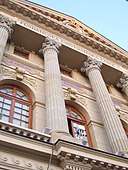
 The facade at Bletchley Park (UK) is a mix of architectural styles
The facade at Bletchley Park (UK) is a mix of architectural styles- Detail of a façade from Prague (Czech Republic)
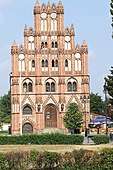
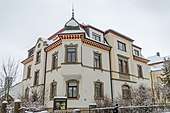 Façade of a house from Ansbach (Germany)
Façade of a house from Ansbach (Germany)- The Haunted Mansion in Disneyland consists of a building and facade in the front, while the majority of the ride is outside the park in a connected building
- "Energetic rebuilding of a facade" (Germany): The outer walls are torn off and replaced at one wing of the building at a time while the other wing part is still/again in use
 Fantasy Gardens (British Columbia) was a theme park with an exterior designed to resemble many different medieval buildings
Fantasy Gardens (British Columbia) was a theme park with an exterior designed to resemble many different medieval buildings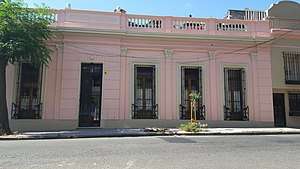 Facade of a typical "Casa Chorizo" house with different ornaments and colors in Buenos Aires (Argentine)
Facade of a typical "Casa Chorizo" house with different ornaments and colors in Buenos Aires (Argentine)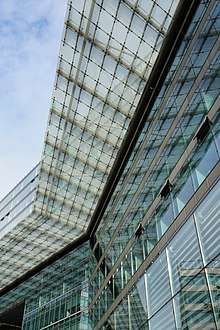 Detail of the glass facade of "Neues Kranzler Eck" by Helmut Jahn, located in Berlin
Detail of the glass facade of "Neues Kranzler Eck" by Helmut Jahn, located in Berlin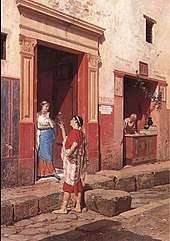
Notes
- dictionary.cambridge.org
- Boswell, Keith. "Exterior Building Enclosures". John Wiley & sons, Inc, 2013, p. 11
- "façade, n.". Oxford English dictionary (Second, online ed.). Oxford University Press. December 2011 [1989]. (subscription required)
- Jean Manco. Bath's lost era, "Bath and the Great Rebuilding", Bath History vol. 4, (Bath 1992). First published in Bath City Life Summer 1992. Retrieved 22 June 2010
References
- Façades: Principles of Construction. By Ulrich Knaack, Tillmann Klein, Marcel Bilow and Thomas Auer. Boston/Basel/Berlin: Birkhaüser-Verlag, 2007. ISBN 978-3-7643-7961-2 (German) ISBN 978-3-7643-7962-9 (English)
- Giving buildings an illusion of grandeur
- Facades of Casas Chorizo in Buenos Aires, Argentina
Further reading
- Poole, Thomas (1909). . In Herbermann, Charles (ed.). Catholic Encyclopedia. 5. New York: Robert Appleton Company. The article outlines the development of the facade in ecclesiastical architecture from the early Christian period to the Renaissance.